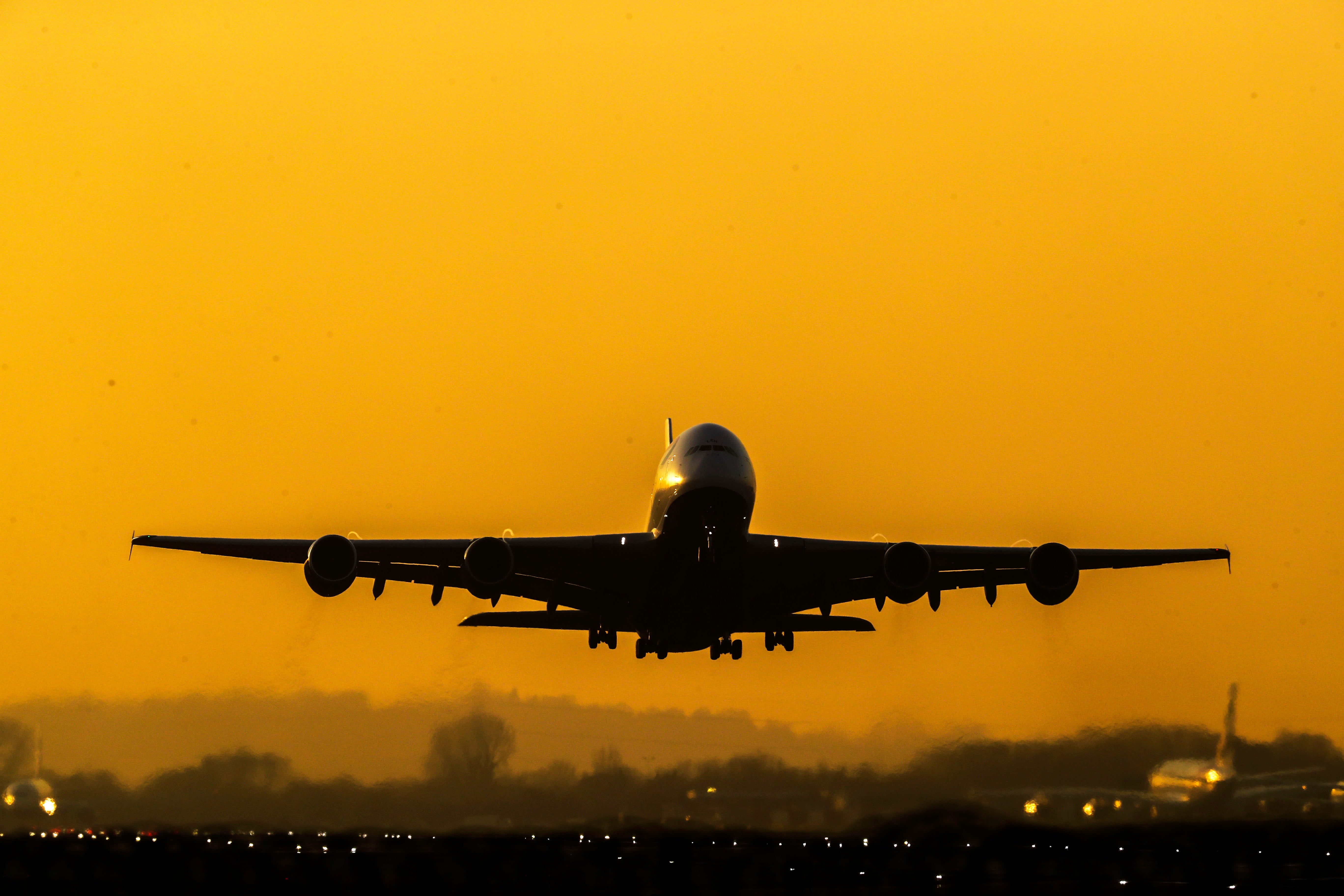Why the government’s Jet Zero strategy for ‘guilt-free flights’ is an absolute farce
The Department for Transport is promising to ‘reach net zero aviation and deliver guilt-free flying’ – but if something sounds too good to be true, it usually is, writes Helen Coffey


There’s an exquisite kind of irony in the government releasing its “Jet Zero” strategy, outlining how it will “reach net zero aviation and deliver guilt-free flying”, on the same day that the UK is set to hit its highest temperature on record, and with Europe literally burning amid raging wildfires.
No one but the most diehard of climate change deniers can continue to dismiss the fact that the world is hotting up at an alarming pace; the evidence is right in front of us, written in the rising mercury in giant, unignorable letters. And yet this latest report from the Department for Transport (DfT), which talks excitedly of “cutting-edge industries”, “new technologies” and “new infrastructure” – even employing the phrase “the sky’s the limit” to kick it all off – has its head buried so deep in the sand it’s practically reached the Earth’s molten core (which is only marginally hotter than central London right now).
Because amid all the six-point plan’s whizzy-sounding techno fixes like “zero emission aircraft”, and the impressive-sounding investment – to the tune of £165m for an Advanced Fuels Fund to develop a domestic sustainable aviation fuels (SAF) industry – the strategy seems to be missing one key word: reduce.
The strategy seems to be missing one key word: reduce
There is not a single mention of reducing the number of planes in the sky, nor the number of flights taken. And the simple fact is, to hit net zero carbon emissions by 2050, we need to be flying less and less each year.
“Rather than a pragmatic plan to fully wean the aviation industry off fossil fuels, it allows the sector to carry on polluting with impunity for the next 30 years,” says Matt Finch, UK director at green group Transport & Environment (T&E), of the report. “Whilst there are some good commitments, it will go down in history as a missed opportunity."
Tim Johnson, director of the Aviation Environment Federation (AEF), adds: “Ministers are not being honest about what it will take to achieve net zero flying. The strategy avoids answering the difficult questions like the need to fly less, and calling a halt to airport expansions.”
The report does commit to the aim of “ensuring that emissions do not go above 2019 levels”, which is at least a start.
But every “solution” outlined in Jet Zero – improving efficiency for aircraft and airspace use, developing SAFs, investing in zero-carbon planes using electricity and hydrogen, developing carbon markets and greenhouse gas removal technologies – none of it will even begin to touch the sides.
Here’s the stark truth: SAFs, which still emit as much carbon as regular kerosene inflight but potentially emit less carbon or even remove it during the production process, cannot be produced at anywhere near the scale needed for the number of flights we take. As Cait Hewitt, policy director at AEF, points out: “to make enough synthetic e-fuel to meet the existing jet fuel demand from the UK aviation sector would require an offshore wind farm the size of Northern Ireland”.
The government has outlined an SAF mandate that will “require at least 10 per cent of jet fuel to be made from sustainable sources by 2030” – still ambitious with the small amount of capacity we have but, even if that target is met, 90 per cent of fuel used will be the normal stuff. Plus, in the words of T&E, “not all SAFs are created equal and it’s essential to deploy the most sustainable ones”.
Ministers are not being honest about what it will take to achieve net zero flying
Zero-emissions aircraft, “with the aspiration of having zero-emission routes connecting places across the UK by 2030”? Sure, that sounds sexy and exciting. But realistically, the barriers of infrastructure, cost and inherent limiting factors in the technology itself mean these new types of plane aren’t likely to be flying commercially in the next decade – and, when they do, they’ll only be suitable for domestic or very short hops, and can likely only carry small numbers of passengers at a time. “Commercial electric or hydrogen planes will not be seen before 2035, and even then they are likely to be small regional aircraft operating on short routes,” says AEF. Again, even if the target is met, the strategy still leaves UK aviation burning half of the fossil fuels it currently does in 2050 (approximately 19 million tonnes), according to T&E, which, in their words, “is simply not good enough in a climate emergency”.
Improving efficiency within the existing frameworks and tech that we have is the easiest step to take – the government has pledged to “improve fuel efficiency by 2 per cent every year” and provide “a further £3.7m in 2022/23 to support airports to modernise their airspace” – and is all well and good. But again, the emissions saved will be negligible, never compensating for the ever-growing number of flights.
And then there’s “developing carbon markets and greenhouse gas removal technologies to drive decarbonisation and offset any residual emissions”. Essentially, offsetting – an area that’s so complex and problematic I’m not even going to attempt to deep-dive into it here. But what I will say is this: to reach net zero, the only “offsets” that can be left are carbon removals, whereby a scheme literally scrubs carbon from the atmosphere. There is limited capacity for this kind of technology – because it either takes massive amounts of energy or land – and therefore it needs to be used responsibly for the emissions that are absolutely essential within our society. Boundless leisure flying is, I’m afraid to say, not that.
Other aims outlined barely seem worth mentioning – “providing consumers with better information so they can make sustainable aviation choices”, for example, is laughable considering there are no “sustainable” aviation choices at present. The target should be to educate people so they can make more sustainable travel choices, surely? Highlighting the carbon savings by travelling by train or bus instead?
And the final nonsensical bullet-point: “Increasing our understanding of the non-CO2 impacts of aviation, such as contrails and nitrogen oxides.” The report claims that “effects of these remain uncertain so we will work closely with academia and industry to monitor global developments in this area”. More research is always welcome, of course – but as early as 1999 a special report by the Intergovernmental Panel on Climate Change (IPCC) estimated that the total historic impact of aviation on the climate when factoring in non-CO2 emissions – like water vapour, aerosols, nitrogen oxides etc – was two to four times higher than when looking at CO2 alone.
We already know that short-haul flights contribute an extra 121kg of CO2e (carbon dioxide equivalent) per kilometre when you factor in these other emissions, while long-haul flights contribute an extra 93g more per kilometre. Making out that we “don’t know” their impact and just need to “keep an eye on it for a bit” – rather than take any action now – seems, to me, to be setting the bar extraordinarily low.
I know this might all sound totally doom-mongering of me. I know people don’t always want to hear it. But there’s no getting around reality: aviation cannot decarbonise at the scale or speed needed to make a real impact. As Alethea Warrington, campaigner at climate charity Possible, puts it: “Heavily relying on undeveloped, extremely expensive or unworkable technologies, the strategy crucially fails by leaving out a policy to fairly reduce the demand for flights such as a frequent flyer levy.”
We need to be flying less, not more, in the years and decades to come to hit net zero. A strategy that makes no mention of that – nor of even limiting the growth of aviation, and ensuring there aren’t more flights year on year – is no kind of strategy at all.
‘Zero Altitude: How I learned to Fly Less and Travel More’ by Helen Coffey is out now, published by Flint (flintbooks.co.uk; £16.99 hardback).
Join our commenting forum
Join thought-provoking conversations, follow other Independent readers and see their replies
Comments

Bookmark popover
Removed from bookmarks